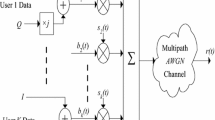Abstract
Since the conventional detector performs poorly in bandwidth-efficient Code Division Multiple Access (CDMA) systems, several multiuser detectors were proposed recently. In this paper, we compare performance of the decorrelator, the two-stage detector (2S), and the decision-feedback detector (DF) for the Rayleigh flat fading synchronous CDMA channel. First, assuming perfect channel estimation, we show that the 2S and the DF have much lower bit error rate (BER) than the decorrelator, and prove that the ideal DF has unity Asymptotic Multiuser Efficiency (AME). Furthermore, we evaluate the performance of these detectors in the presence of channel mismatch. We model the Rayleigh flat fading channel as the second order Auto Regressive (AR) process, and use the Kalman filter as the channel estimator. The lower bounds on the BER of the 2S and the DF are derived. The analytical results and the simulations show that the estimation error accumulated due to cancellation of other users limits the performance of the 2S and the DF. Therefore, in the presence of channel mismatch, the decorrelator offers comparable or even better performance than more complex decision-feedback and two-stage detectors.
Similar content being viewed by others
References
K.S. Gilhousen et al., “On the Capacity of a Cellular CDMA System”, IEEE Transactions on Vehicular Technology, Vol. 40, No.2, May 1991, pp. 303–312.
W.C.Y. Lee, “Overview of Cellular CDMA”, IEEE Transactions on Vehicular Technology, Vol. 40, No.2, May 1991, pp. 291–302.
R. Kohno, R. Meidian, L.B. Milstein, “Spread Spectrum Access Methods for Wireless Communications”, IEEE Communication magazine, Vol. 33, No.1, Jan. 1995, pp. 58–67.
S. Verdu, “Minimum Probability of Error for Asynchronous Gaussian Multiple-Access Channel”, IEEE Transactions on Information Theory, Vol. IT-32, No.1, Jan. 1986, pp. 85–96.
R. Lupas, S. Verdu, “Linear Multiuser Detectors for Synchronous Code-Division Multiple-Access Channel”, IEEE Transactions on Information Theory, Vol. IT-35, No.1, Jan. 1989, pp. 123–136.
M.K. Varanasi, B. Aazhang, “Near-optimum Detection in Synchronous Code-Division Multiple Access Channel”, IEEE Transactions on Communications, Vol. COM-39, No.5, May 1991, pp. 725–736.
A. Duel-Hallen, “Decorrelating Decision-Feedback Multiuser Detector for Synchronous Code-Division Multiple Access Channel”, IEEE Transactions on Communications, Vol. COM-41, No.2, Feb. 1993, pp. 285–290.
P. Patel, J. Holtzman, “Analysis of a Simple Successive Interference Cancellation Scheme in DS/CDMA System”, IEEE JSAC - Special issue on CDMA, Vol. 12, No.5, June 1994, pp. 796–807.
P. Dent, B. Gudmundson, M. Ewerbring, “CDMA-IC: A Novel Code Division Multiple Access Scheme Based on Interference Cancellation”, Proc. of PIMRC’ 92, Boston, MA, Oct. 1992, pp. 98–102.
A. Duel-Hallen, “A Family of Multiuser Decision-Feedback Detectors for Asynchronous Code-Division Multiple-Access Channels”, IEEE Transactions on Communication, Vol. 43, No.2/3/4, Feb./March/April 1995, pp. 421–434.
Z. Zvonar, D. Brady, “Multiuser Detection in Single-Path Fading Channels”, IEEE Transactions on Communication, Vol. COM-42, No.4, April 1994, pp. 1729–1739.
H.Y. Wu, A. Duel-Hallen, “Performance of Multiuser Decision-Feedback Detectors for Flat Fading Synchronous CDMA Channels”, Proc. of the 28th Annual Conference on Information Sciences and Systems, Princeton University, Princeton, NJ, March 1994, pp. 133–138.
R. Haeb, H. Meyr, “A Systematic Approach to Carrier Recovery and Detection of Digitally Phase Modulated Signals on Fading Channels”, IEEE Transactions on Communications, Vol. 37, No.7, July 1989, pp. 748–754.
Z. Zvonar, D. Brady, “A Comparison of Differentially Coherent and Coherent Multiuser Detection With Imperfect Phase Estimates in a Rayleigh Fading Channel”, Proc. of the 1993 International Symposium on Information Theory, p. 48.
Z. Zvonar, Multiuser Detection for Rayleigh Fading Channels, Ph.D. Thesis, Chapter 4, Northeastern University, Boston, Massachusetts, 1993.
A. Duel-Hallen, J. Holtzman, Z. Zvonar, “Multiuser Detection for CDMA Systems”, IEEE Personal Communication Magazine, April 1995, pp. 46–58.
H.Y. Wu, A. Duel-Hallen, “Channel Estimation and Multiuser Detection for Frequency-Nonselective Fading Synchronous CDMA Channel”, Proc. of Thirty-Second Annual Allerton Conference on Communication, Control and Computing, Monticello, Sept. 1994, pp. 335–344.
S. Verdu, “Optimum Multiuser Asymptotic Efficiency”, IEEE Transactions on Communication, Vol. COM-34, No.9, pp. 890–897, Sept. 1986.
W.C. Jakes, Jr., Microwave Mobile Communication, John Wiley & Sons, 1974, p. 75.
L. Lindbom, “Simplified Kalman Estimation of Fading Mobile Radio Channels: High Performance at LMS Computational Load”, IEEE ICASSP, Vol. 3, April 1993, pp. 352–355.
B.D.O. Anderson and J.R. Moore, Optimal Filtering, Prentice-Hall, 1979, Chapter 3.
Z. Zvonar, M. Stojanovic, “Performance of Multiuser Diversity Reception in Nonselective Rayleigh Fading CDMAChannels”, Proc. of the Third Communication Theory Mini-Conference (CTMC'94), San Francisco, CA, Nov. 1994, pp. 171–175.
H.Y. Wu, A. Duel-Hallen, “Multiuser Detection with Differentially Encoded Data for Mismatched Flat Rayleigh Fading CDMA Channels”, to appear in Proc. of the 30th Annual Conference on Information Sciences and Systems, Princeton University, Princeton, NJ, March 1996.
J.G. Proakis, Digital Communications, McGraw Hill, 1989.
Wozencraft, Jacobs, Principles of Communication Engineering, John Wiley & Sons, 1965, p. 83.
S. Vasudevan and M.K. Varanasi, “Achieving Near-Optimum Asymptotic Efficiency and Fading Resistance over the Time-varying Rayleigh-faded CDMA Channel”, to appear in IEEE Transactions on Communications, Vol. COM-44, No.9, Sept. 1996.
P.Y. Kam, “Optimal Detection of Digital Data over the Nonselective Rayleigh Fading Channel with Diversity Reception”, IEEE Transactions on Communications, Vol. COM-39, No.2, Feb. 1991, pp. 214–219.
H.A. David, Order Statistics, John Wiley & Sons, 1981.
Author information
Authors and Affiliations
Rights and permissions
About this article
Cite this article
Wu, HY., Duel-Hallen, A. Performance Comparison of Multiuser Detectors with Channel Estimation for Flat Rayleigh Fading CDMA Channels. Wireless Personal Communications 6, 137–160 (1998). https://doi.org/10.1023/A:1008805006624
Issue Date:
DOI: https://doi.org/10.1023/A:1008805006624




